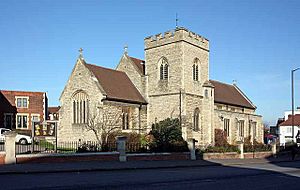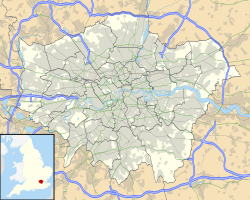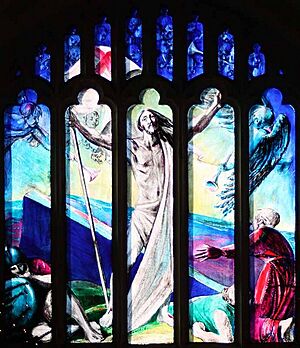St Monica's Church, Palmers Green facts for kids
Quick facts for kids St Monica's Catholic Church |
|
|---|---|
 |
|
| 51°37′27″N 0°6′9″W / 51.62417°N 0.10250°W | |
| Location | Stonard Road, London N13 4DJ |
| Country | England |
| Denomination | Roman Catholic |
| History | |
| Status | Parish church |
| Consecrated | 4 May 1914 |
| Architecture | |
| Functional status | Active |
| Years built | 1913–1914 |
| Administration | |
| Parish | Palmers Green |
| Deanery | Enfield |
| Archdiocese | Westminster |
| Province | Westminster |
St Monica's Catholic Church is a Catholic church located in Palmers Green, north London. It is a place where people come to worship and be part of a community. The church is found at the corner of Stonard Road and Green Lanes in the London Borough of Enfield.
This church is special because it is one of only two churches in the Diocese of Westminster named after Saint Monica. The other one is St Monica's Priory, Hoxton.
St Monica's started as a small mission church in 1910. It later grew into a full parish. A house for the priest, called a presbytery, was built next to the church in 1931.
As of 2021, the church has two priests, a parish sister, and a youth worker. They offer many activities, including community programs and social help, along with regular worship and care for the people.
Contents
The Story of St Monica's Church
The church began as a mission in 1910. Father Thomas Heditch was the first leader. He became ill in 1912 and did not return after a trip.
Then, Father Patrick Gallagher took over on June 27, 1912. Father Gallagher was a builder before he became a priest. He used his skills and contacts to help build St Monica's Church. He worked very hard and managed to complete the church in just two years.
The church officially opened on Monday, May 4, 1914. Cardinal Francis Bourne led the opening ceremony. Nearly 600 people and 40 clergy members attended. The church and the priest's house cost £6,600 to build, including the land.
In 1954, Father Gallagher built St Monica's Primary School. It was located on Cannon Hill in Southgate. This was his last big project. He passed away on December 11, 1957, after finishing his work.
In 1958, the church started an amateur drama group called Saint Monica's Players (SMP). This group still performs musicals in Enfield today. From 1935 to 1987, the church hall was also home to a professional theater, the Intimate Theatre.
Inside the Church
In 1920, Father Gallagher visited Germany. He was very impressed by the wood carving there. He ordered several beautiful items for the church. These included the Sacred Heart altar, statues of St Monica and St Joseph, and confessional boxes.
The Sacred Heart Chapel
The Sacred Heart Chapel is a special part of the church. An early church member gave it as a secret gift. The walls are decorated with colorful stone mosaics in a Byzantine style.
Two angels hold signs with words from Jesus: 'Behold this Heart' and 'Which has so loved men'. The Sacred Heart statue is in the middle of the wooden altar. It is surrounded by detailed carvings. Stained glass windows show Jesus with children. A message below the window asks people to 'Pray for the Donors'.
Statues in the Church
- St Monica: A statue of St Monica stands near the Reconciliation Room. It shows St Augustine as a baby in a boat at her feet. This room was added in 1964.
- St Joseph: The statue of St Joseph is next to the Sacred Heart Chapel. He holds a lily, which is a symbol of purity.
- St Mary: A statue of St Mary is on the north wall. People often light candles here. There is also a Book of Remembrance below it.
The Stations of the Cross
The church has fourteen Stations of the Cross. These are oak carvings that show the story of Jesus' crucifixion. Father Gallagher ordered them, but their exact origin is unknown. They are now placed simply against the church walls.
The Church Organ
The organ was first used at Christmas in 1924. It was described as "An instrument of great power and beautiful tone." A special service was held to bless it in January 1925. The organ was refurbished in spring 2014. It is located in the organ loft, above the church entrance.
The Crucifix
A large wooden crucifix hangs on the south wall of the church. It shows a carved image of Christ. Its origin is unknown. Every year on Remembrance Sunday, the church community faces the crucifix for a short service and two minutes of silence.
Sanctuary Window
The window above the altar was originally plain glass. In 1984, a new window was added by a secret donor. It was painted by Maltese artist Carmel Cauchi. He said it shows "Christ in the glory of His resurrection. Jesus is the light."
Church Lighting
New lights were put in the church in 2010. This was just in time for the 100-year celebration of the parish. The lights were designed to look like the original ones from 1914.
Leaders of the Parish
- 1910 - Father Thomas Heditch
- 1912 - Father Patrick Gallagher
- 1957 - Canon Reginald Crook
- 1964 - Father Raymund Geraerts
- 1979 - Father Robin Whitney
- 1994 - Father Brian Creak
- 2004 - Canon Roger Taylor
- 2008 - Canon Shaun Lennard
- 2017 - Canon Mehall Lowry
Assistant Priests
- 1916 - Father Wilfred Harrington
- 1918 - Father John Sheeran
- 1921 - Father William Gordon
- 1936 - Father Patrick Murphy
- 1949 - Father Henry Dodd
- 1950 - Father Edward Short
- 1951 - Father Peter Boshell
- 1958 - Father Adrian Peeler
- 1963 - Father Hilary Crewe
- 1967 - Father Keith Abram
- 1972 - Father Samuel Steer
- 1979 - Father Frans Azzopardi
- 1986 - Father Patrick Miscampbell OSB
- 1990 - Father Stephen Weaver
- 1995 - Father Dennis Touw
- 2002 - Father Joe Mazarello
- 2004 - Father Shaun Church
- 2007 - Father Philip Dyer-Perry
- 2011 - Father Andrew Gallagher
- 2014 - Father Paulo Bagini
- 2017 - Father John Warnarby
- 2019 - Father Stewart Hasker
- 2022 - Father Paul Zhao SVD
- 2023 - Father David Knight



